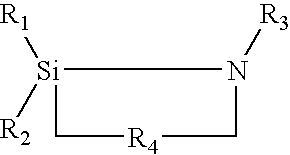Method of preparing hydrophobic silica directly from an aqueous colloidal silica dispersion
a technology of hydrophobic silica and colloidal silica, which is applied in the direction of instruments, silicon compounds, silicon oxides, etc., can solve the problems of difficult to achieve direct treatment of aqueous dispersion of silica, many treating and many treatment agents are difficult to disperse in water
- Summary
- Abstract
- Description
- Claims
- Application Information
AI Technical Summary
Benefits of technology
Problems solved by technology
Method used
Image
Examples
example 1
[0039]The following example illustrates the preparation of hydrophobic silica particles by treating a hydrophilic colloidal silica dispersion with a treating agent, in accordance with the invention.
[0040]Hydrophobic silica particle samples 1A-3A were prepared from the commercially available hydrophilic colloidal silica dispersions indicated in Table 1. Hexamethyldisilazane [HMDZ] was added directly to each of the hydrophilic colloidal silica dispersions in a 2 liter 3-necked flask fitted with an overhead agitator and 0.6 cm (0.25 inch) thermocouple, and the mixtures were stirred rapidly at room temperature (19-21° C.) at a rate such that the vortex of the dispersion extended at least to the top of the agitator blade. Stirring at this rate was continued for the duration of the reaction time, which was between 20 and 24 hours. Table 1 provides the specific reaction times and the amount of silica dispersion and HMDZ used in preparing each sample. Intermediate samples were removed from ...
example 2
[0046]The following example illustrates the preparation of hydrophobic silica particles by treating a hydrophilic colloidal silica dispersion with HMDZ and subsequently isolating and washing the hydrophobic silica particles, in accordance with the invention.
[0047]Hydrophobic silica particle samples 2A and 2B were prepared from the commercially available hydrophilic colloidal silica dispersions indicated in Table 4. HMDZ was added directly to each hydrophilic colloidal silica dispersion in a 100 mL round bottomed flask fitted with a magnetic stir bar, and the mixtures were stirred rapidly at room temperature (19-21° C.) at a rate such that the vortex of the dispersion extended at least to the top of the stir bar. Stirring at this rate was continued for the duration of the reaction time specified in Table 4. Table 4 provides the amount of silica dispersion and HMDZ used in preparing each sample.
[0048]After allowing the dispersions to react for the specified time, each dispersion was p...
example 3
[0052]The following example illustrates the effect of reaction time and temperature on the preparation of hydrophobic silica particles in accordance with the invention.
[0053]Hydrophobic silica particle samples 3A-3C were prepared from the commercially available hydrophilic colloidal silica dispersions indicated in Table 5. HMDZ was added directly to each hydrophilic colloidal silica dispersion, and the mixtures were stirred rapidly at room temperature (19-21° C.) at a rate such that the vortex of the dispersion extended at least to the top of the agitator blade. Stirring at this rate was continued for the duration of the reaction time specified in Table 5. Table 5 provides the amount of silica dispersion and HMDZ used in preparing each sample. Intermediate samples were removed from the reaction at various times, dried on a moisture balance at 160° C., and analyzed for carbon content. These results are provided in Table 6.
[0054]After allowing the dispersions to react for the specifie...
PUM
| Property | Measurement | Unit |
|---|---|---|
| particle size | aaaaa | aaaaa |
| temperature | aaaaa | aaaaa |
| temperature | aaaaa | aaaaa |
Abstract
Description
Claims
Application Information
 Login to View More
Login to View More - R&D
- Intellectual Property
- Life Sciences
- Materials
- Tech Scout
- Unparalleled Data Quality
- Higher Quality Content
- 60% Fewer Hallucinations
Browse by: Latest US Patents, China's latest patents, Technical Efficacy Thesaurus, Application Domain, Technology Topic, Popular Technical Reports.
© 2025 PatSnap. All rights reserved.Legal|Privacy policy|Modern Slavery Act Transparency Statement|Sitemap|About US| Contact US: help@patsnap.com


